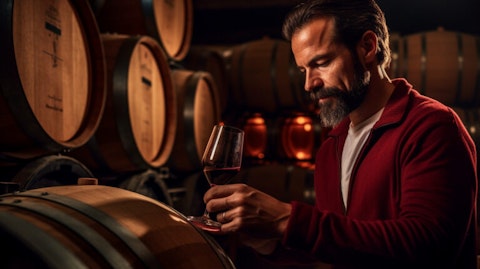The Duckhorn Portfolio, Inc. (NYSE:NAPA) Q4 2023 Earnings Call Transcript September 27, 2023
The Duckhorn Portfolio, Inc. beats earnings expectations. Reported EPS is $0.15, expectations were $0.13.
Operator: Good afternoon and thank you for attending today’s Duckhorn Portfolio Q4 and Full Year 2023 Earnings Conference Call. My name is Sierra [ph] and I’ll be your moderator for today. [Operator Instructions] I would now like to pass the conference over to our host, Sean Sullivan. Please proceed.
Sean Sullivan: Good afternoon and welcome to The Duckhorn Portfolio’s fourth quarter and fiscal year 2023 earnings conference call. Joining me on today’s call is Jennifer Fall Jung, our Chief Financial Officer. Following my opening remarks, Jennifer will walk us through our quarterly results and the details of our fiscal year 2024 financial guidance that we are issuing today. I will then conclude with some closing remarks before we take questions. By now, everyone should have access to the earnings release for the fiscal quarter and fiscal year ended July 31, 2023, that was distributed at approximately 4:05 PM Eastern Time. The press release and an accompanying presentation are accessible on the company’s website at ir.duckhorn.com.

A winemaker examining a glass of red wine from a barrel in a cellar. Editorial photo for a financial news article. 8k. –ar 16:9
And shortly after the conclusion of today’s call, a webcast will be archived for the next 30 days. Before we begin, I would like to remind you that today’s discussion contains forward-looking statements based on the environment as we currently see it and as such, includes risks and uncertainties. If you refer to Duckhorn’s earnings release, as well as the company’s most recent SEC filings, you will see a discussion of factors that could cause the company’s actual results to differ materially from these forward-looking statements. Please remember, the company undertakes no obligation to update or revise these forward-looking statements in the future. We will make a number of references to non-GAAP financial measures. We believe that these measures provide investors with useful perspective on the underlying growth trends of the business and have included in our earnings release a full reconciliation of non-GAAP financial measures to the most comparable GAAP measures.
In addition, please note that all retail scanner data cited on today’s call is sourced from Circana which was formerly known as IRI. And we’ll refer to dollar consumption for the 12-week period ended July 30, 2023 and growth versus the same period in the prior year in U.S. tax [ph] channels, unless otherwise noted. Before we discuss our financial performance and outlook, I would like to share an update about our company’s leadership team. As you may have seen in a press release issued a few moments ago, we have announced that Alex Ryan retires as our President, Chief Executive Officer and Chairman, to focus on family and personal matters. We wish Alex well and thank him for his 35 years of leadership and service at The Duckhorn Portfolio. In light of Alex’s retirement, I’m also pleased to announce that our Board of Directors voted to appoint Deirdre Mahlan to act as our Interim President, Chief Executive Officer and Chairwoman.
Deirdre is an excellent choice to lead our Company through this transition, given her close work with the company and management over the past nearly three years and her extensive expertise in the alcohol beverage industry. Deirdre spent nearly 20 years in leadership positions at Diageo. From 2010 to 2015, she served as Chief Financial Officer of Diageo PLC. She also served as Chief Executive Officer of Diageo North America between 2015 and 2020. Since early 2021, she has been a key collaborator with the company’s veteran leadership team that continues to boast more than 60 years of collective experience at Duckhorn. My colleagues joined me in excitement about Deirdre accepting this most important leadership role in our company. Stepping back, the success of The Duckhorn Portfolio has always been the result of our philosophy, the collaborative efforts of our amazing team and our unwavering commitment to producing the highest quality wines.
At its core, The Duckhorn Portfolio is made up of more than 500 passionate employees. Our team, our values and our commitment to excellence have always been and always will be the foundation of our success. We look forward to you getting to know Deirdre very soon as she settles into her new role at the company. Moving now to our financial results, I’d like to start by saying how pleased we are with our fourth quarter and full year performance. Net sales grew 28% in the fourth quarter, resulting in full year sales growth of 8%, complemented by full year adjusted EBITDA growth of 13%. Our strategies to drive profitable sales growth through leveraging our brand strength, evolving our portfolio, expanding our wholesale network and growing our DTC channel continues to pay off.
Before Jennifer discusses additional details about our performance, I will share some observations on the industry, including recent trends in retail wine sales. Stepping back with a broad view, we are pleased to see signs that the total U.S. wine industry seems to be turning the corner. The $25 and up subsegment turned positive in the 12-week period ended July 30, 2023; and the luxury wine segment, wines at $15 and above, grew at 5.4% in the same 12-week period. We continue to outpace the broader luxury segment on a full-year basis. The Duckhorn Portfolio grew 9.1% versus just 1.6% for the luxury segment during the same period, as measured by Circana. We are encouraged by wine trends showing signs of a rebound and remain confident in our ability to continue to outperform the luxury wine segment and take care in this coming fiscal year.
Now, I would like to note a few highlights from the fourth quarter. First, on the topline, we performed in line with our expectations, with net sales increasing 28% over the prior year. We planned fourth quarter growth to be the most robust of the year, given the cadence dip in our Kosta Browne Appellation offering and expected strong wholesale growth; and we achieved this. Wholesale net sales increased 20%, with performance strongest earlier in the quarter. Direct-to-consumer net sales increased 75%, driven by the shift of the Kosta Browne Appellation offering from the third quarter last year to the fourth quarter this year. Second, our volume grew by 10.6% which reflects an acceleration over the third quarter. Consistent with typical seasonality patterns, shipment growth in the quarter modestly outpaced depletion growth but depletion growth and shipment growth were in line with our expectations for the full fiscal year.
And importantly, at the end of the fourth quarter, wholesale channel inventories were consistent with our expectations. Third, our portfolio remained a category growth leader within the $15 and up luxury segment, where we continue to take care. And finally, we posted an improved adjusted EBITDA margin of 34.2% versus 28.6% in the prior year. The fourth quarter benefited from the shift of the Kosta Browne Appellation offering and robust gross margin expansion, resulting from opportunistically lean trade spend. Let me take a moment to update you on another aspect of our growth strategy, growing the number of accounts in which our luxury wines are sold. As part of our annual assessment of our total addressable market for the wholesale channel, we calculate the number of accounts in which our luxury wines are sold and set a target for its future growth.
We are pleased to see the number of accounts sold grow from 59,000 as of June 30, 2022, to 65,000 as of June 30, 2023, reflecting greater than 10% growth in the number of accounts. There remains significant white space. We are targeting that the number of accounts at which our wines are sold to grow at a CAGR of 7% to 8% over the next 4 years. I would like to share a brief update on the production winery we acquired in June in Sonoma County. As we have noted before, our strategy with respect to the acquisition of production assets is to optimize the balance between in-house production and the use of custom crush partners in a manner that enhances the quality of our wines, increases diversification and optionality and reflects an efficient use of capital.
Production wineries of this scale are rarely available in California. And this acquisition reduces our reliance on third-party custom processing, storage and bottling and takes a longer-term view with respect to future capacity requirements to meet our long-term growth plans. By optimizing our production processes and affording us greater visibility into our cost of goods in future years, we view this acquisition as an investment in our future growth, our winery brand and our financial performance. With that, I’ll now hand over the call to Jennifer to take us through our Q4 performance and preliminary fiscal 2024 guidance.
Jennifer Fall Jung: Thank you, Sean; and good afternoon, everyone. Beginning with our topline, net sales were $100.1 million, an increase of 28.3% compared to prior year and consistent with our expectations. The growth was driven by both strong price mix and volume growth, supported meaningfully by the shift in the Kosta Browne Appellation series offering into the fourth quarter of this year. We have a long-term pricing strategy for our luxury wines and our planned price increases during the past fiscal year were well received by both retailers and consumers alike. We continue to take care at all price points within the portfolio. Our D2C channel was a major driver of our consolidated net sales growth, benefiting from the previously discussed shift in cadence of the Kosta Browne Appellation series offering.
As a reminder, this movement is simply a cadence shift that was a headwind in the third quarter and a tailwind in the fourth quarter. Wholesale shipment growth outpaced depletion growth in the fourth quarter but the shipment growth and depletion growth were imbalanced for the full fiscal year. On a net sales basis, the wholesale channel posted strong double-digit growth driven by off-premise demand from national accounts. From a sub-channel perspective, off-premise was a key growth driver in the quarter, outperforming the growth of our on-premise sub-channel and showing strength in depletion, accounts sold and number of labels per account. Despite lapping a tough prior year comparison that had benefited from the continued on-premise reopening, we still grew our on-premise account base this quarter.
As we have noted on prior earnings calls, our exclusive focus as a producer of luxury wines means that we emphasize placement of our wines on wine lists in fine dining restaurants and other on-premise locations. To expand briefly, on the net sales performance by sub-channel in the fourth quarter, the wholesale to distributor sub-channel continues its growth trajectory this quarter, increasing an impressive 23.9% over the prior year, driven by a combination of case volume growth and favorable brand mix led by our Duckhorn Vineyard and Decoy winery brands, with continued expansion of Decoy Limited in the channel. The California direct-to-trade sub-channel was up 7.3% compared to the prior year on healthy volumes and pricing. We are pleased to see this growth in California which is already our strongest state.
The direct-to-consumer channel increased 75% when compared to the prior year. This increase was largely anticipated given the cadence shift of our Kosta Browne offering. Excluding the impact of the timing shift, B2C net sales would have increased solidly in the quarter. Our strategy to drive our direct-to-consumer business through customer engagement in our tasting room is proven out as our per-person spend is higher than pre-pandemic levels. Fourth quarter gross profit was $55.3 million, an increase of $16 million or 40.6% compared to prior year. This represents a 55.2% gross margins, up approximately 480 basis points year-over-year, improving due to the shift in the timing of the Kosta Browne Appellation series offering and in our wholesale channel as a result of successful planned price increases and lower discounting.
Total selling, general and administrative expenses were $30.4 million, an increase of $2.7 million or 9.8%. The increase was primarily attributed to higher compensation costs as we continue to invest in our workforce and deliver on our long-term growth strategy. Net income was $17.8 million or $0.15 per diluted share. Adjusted net income was $16.7 million or $0.15 per diluted share which nearly doubled from our fourth quarter of last year. The increase in adjusted net income was driven by higher net sales and higher gross margin percent compared to the prior year, partially offset by higher operating expenses, interest and income taxes. Adjusted EBITDA was $34.2 million, an increase of $11.9 million or 53.5% year-over-year growth. Adjusted EBITDA margin improved 560 basis points versus the prior year.
The increase was driven by higher net sales and improved gross margin primarily as a result of pricing optimization, partially offset by higher operating expenses. Overall, our fourth quarter was a solid end to a strong year at The Duckhorn Portfolio. At the end of the quarter, we had cash of $6.4 million and total debt of $233.8 million. As a result, our leverage ratio declined to 1.6 times net debt. Let’s turn now to our initial outlook for full year fiscal 2024. While we are mindful that ongoing macro uncertainty can impact customer discretionary spending, we believe we are well-positioned to continue outperforming the overall wine industry and taking share in luxury wine due to our superior brand strength and scaled, highly diversified business model.
We expect to realize volume-driven topline growth of mid-to-high single-digits. Net sales contribution will be balanced across our sub-channels and brands with a profitability growth consistent with the topline. Adjusted SG&A will increase in total dollars but decrease as a percentage of net sales, as we continue to make disciplined investments to execute against our considerable distribution of white space opportunity which underpins our long-term strategy. For fiscal year 2024, we expect net sales in the range of $420 million to $430 million which represents growth of 4% to 7%. Adjusted EBITDA in the range of $150 million to $155 million which represents growth of 4% to 7%. Adjusted EPS in the range of $0.67 to $0.69 per diluted share. This includes approximately $0.02 per diluted share of pressure due to the Geyserville facility acquisition in late fiscal year 2023.
Capital expenditures of approximately 8% to 10% of net sales. Interest expense in the range of $14 million to $16 million. And an effective tax rate of 25% to 27% of free tax income on a U.S. GAAP basis. Due to the seasonality of our business and the variance in prior year comparatives, we thought we would provide some additional color on Q1 and the first-half dynamics. While the first half of the year is expected to be proportionally in line with last year, growth will be specifically within Q2, with Q1 to show some downward pressure as we lap some shipment timing in the first half of the prior year. For Q1, we are looking for a high-to-mid single-digit decline given last year’s steep wholesale increase. As a reminder, the prior year Q1 benefited from shipment timing favorability, part of which was pulled forward from Q2 into Q1 as distributors stocked up to avoid logistical challenges or to secure inventory before price increases.
I want to reiterate, as we have discussed in the past, that quarter-to-quarter volatility in shipment volume is common, given the relative size of our wholesale channel business and the timing movements across quarters are not meaningful indicators of the underlying health of the business. In terms of seasonality, we expect first-half and second-half proportionality that is generally in line with our historic trends. We also note that the second-half includes some refinements to shipment cadence between Q3 and Q4 for our Kosta Browne offering as we continue to strive for the optimal customer experience in bringing these exceptional wines directly to our customers. These movements in shipment timing will bring net sales out of Q4 and into Q3 relative to prior year.
For fiscal year 2024, we anticipate downward pressure on gross margin of up to 50 basis points as we restore pricing to more normalized levels. On a full-year basis, our growth outlook is in line with our long-term growth algorithm and we remain prudently optimistic despite some potential industry and macroeconomic pressure. In conclusion, we are pleased with our fourth quarter and full-year 2023 results. We continue to outperform and take share within the luxury wine segment. And I believe we remain in an advantageous position within our industry as we look forward to a strong fiscal year ahead. I will now hand it back over to Sean for closing remarks.
Sean Sullivan: Thank you, Jennifer. We are very pleased with our strong financial results and our consistent outperformance of the luxury wine segment. While the impacts of the short-term macroeconomic environment are challenging to predict, we are confident that The Duckhorn Portfolio will continue to deliver in the long-term against our growth strategy with results that demonstrate the strength of our brands and the resiliency of our customers. We remain committed individually and as a team to delivering sustainable, profitable growth and will always strive to create value over the long-term for our stockholders. With that, Jennifer and I are available to take your questions. And we would appreciate a focus on questions about our business strategy, financial performance and guidance for the new fiscal year.
My statements earlier in the call and also the press release issued earlier this afternoon include all of the information we have to share today with respect to the CEO transition.
See also Top 20 Weed Smoking Countries in the World and 20 Countries with the Most Expensive Beer.
Q&A Session
Follow Duckhorn Portfolio Inc.
Follow Duckhorn Portfolio Inc.
Operator: We will now begin a question-and-answer session. [Operator Instructions] Our first question today comes from Christian Junquera with Bank of America.
Christian Junquera: You have Christian on for Pete. Before we ask our question, I just want to say it was a pleasure working with Alex and we wish him the best. First, what needs to…
Jennifer Fall Jung: We do too.
Christian Junquera: Sorry, go ahead.
Sean Sullivan: I said we do too.
Christian Junquera: So first question and then I have a quick follow-up. What needs to transpire for you guys to hit the high end of your sales and EBITDA outlook?
Jennifer Fall Jung: This is Jen. Nice to meet you. As we talked about a little bit in our performance in FY 2023, part of our longer term goal in terms of gaining market share really comes from really our accounts growth that we see in both on and off premise, as well as continuing to attract new customers into our portfolio. So we will continue with that strategy. It has been working. And we definitely see a path for that for our upper end of our guidance. We are just keeping in mind that there are macroeconomic and industry headwinds out there but we feel really good about our topline guidance that we’ve put forth.
Christian Junquera: Okay. Perfect. And then one follow-up. I believe you touched on this towards the end of your remarks but just the cadence of seasonal revenue for fiscal ‘23 changed, because of the timing of Kosta Browne shipments. Now, is it fair to assume that sales seasonality for fiscal ‘24 for the first and second half should look closer to what it was in fiscal ‘23, right? Are we thinking about that correctly?
Jennifer Fall Jung: Yes, directionally. We say proportionately we feel on a half basis which I think is where you were starting, you should see the same cadence on a half basis, just keeping in mind that we feel really great about the Kosta Browne offering and how it performed in Q4, obviously driving a lot of growth. But we do think moving it back into Q3 will be more optimal for our customers. So you just have to think about that as you’re looking at the quarters.
Sean Sullivan: And, Christian, we have an investor deck that was just filed a few minutes ago as well. If you take a look at that, it’s got a really helpful schematic that will put a finer point on that for you with respect to the Kosta Browne offering.
Christian Junquera: Perfect. I’ll pass it along.
Operator: Our next question comes from Lauren Lieberman with Barclays.
Lauren Lieberman: First, just want to touch on the off-premise versus on-premise trends. I know you’d mentioned that off-premise was outperforming. But what sort of assumptions underpin the ‘24 guidance in that regard? And then also within the on-premise, just curious what you’re seeing in terms of consumer trade-down, how you feel about your availability on wine lists of having some of your lower or more moderately priced offerings available in key accounts at this point, or if that’s something that is building as an opportunity to have more installation.
Jennifer Fall Jung: This is Jen. Great to meet you. Yes, how we saw performance, as we mentioned in our speech this year, was a lot of the growth did come from off-premise which we felt really good about; solid growth. Both on-premise and off-premise had account growth in the quarter and on the year. So we are seeing favorable results in each channel. What you saw in on-premise is that based on FY ‘22, there’s just a bigger hurdle, so the comps were a little bit tougher. So although it did grow and we feel great with the performance, we were just comping a reopening in 2022 of on-premise. As we look forward, part of our growth trajectory is to expect that both on- and off-premise will continue to grow from an account perspective and that’s where our new sales team is focused, as well as the rest of the leadership team.
And we will continue to get more of our wines into both the on-premise and off-premise category, knowing that there are some puts and takes with label mixes as we move through a year.
Sean Sullivan: And with respect to trade-down, I would note relative stability, frankly, across the price points in the portfolio. The luxury wine category experienced a softening of demand and then some increases in its overall performance but we’re focused on our performance relative to that which has continued to be quite strong as we take share. I would point out also our account growth which I think, the first of the three key vectors to wholesale growth, going from 59,000 to 64,000 as of June 30, 2023 and a projection that we take out at a CAGR of 7% to 8% over the next 4 years for growth, that’s comprised primarily more so of off-premise than on but that is, I think, the underlying element of wholesale that also should be kept in mind.
Lauren Lieberman: Okay. Great. And then also I just wanted to ask about promotions. I know your goal has been to keep making progress on kind of tempering promotions. Just any kind of color you could frame kind of the work that’s been done over fiscal ‘23 and kind of how much room is left going forward on that promotional depth and frequency conversation?





